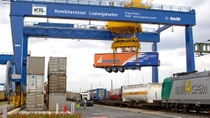Sustainability
Reducing emissions along the value chain
At our production sites and along the value chain with our partners, we work continuously to reduce the greenhouse emissions from our business activities.
Chemical production requires a large amount of energy and some processes also create greenhouse gases as by-products. Our aim is to continuously reduce the greenhouse gas emissions resulting from the generation of energy in power plants and from the production processes. Our experts are constantly working on further improving the processes and setup of our installations.
Since 1990, we have been able to lower our overall greenhouse gas emissions from BASF operations by 57.8% and even reduce specific emissions (per metric ton of sales product) by 74.5%
Scope 3 emissions along the BASF value chain in 2023a
Nitrous oxide decomposition catalysts
The use of nitrous oxide (N2O) decomposition catalysts is an important lever for emission reduction in our production. We have installed our own N2O decomposition catalysts in all plants where nitrous oxide is created as a by-product.
Sustainable energy supply for production sites
Energy is one of the main cost drivers of production. Therefore an efficient energy generation and use of energy in the production is very essential for BASF. The Energy Verbund and combined heat and power plants are of major importance in that respect.
We are continuously exploring the use of renewable energies. To ensure access to energy from renewable sources, we are pursuing a make and buy approach. Firstly, BASF is investing in its own renewable power assets, particularly offshore wind farms. Secondly, BASF will purchase green power on the market through long-term supply agreements with plant operators, green power agreements or renewable energy certificates, depending on the region and market regulations. A key purchasing criterion is the “additionality” of the energy purchased. This means that power is primarily generated by new wind and solar farms.
Energy Verbund

The Verbund system is also key to carbon-optimized energy supply at our sites. It helps us realize synergies and manage value chains in a resource-efficient way. For example, waste heat from one plant’s production process is used as energy in other plants. The Verbund saved us around 17.3 million MWh in 2023, which translates to 3.5 million metric tons less CO2 released into the atmosphere. With combined power and steam generation as well as our continuously optimized Energy Verbund, we were thus able to avoid a total of 5.7 million metric tons of CO2 emissions in 2023.
Combined heat and power

In 2023, we covered 51% of our electricity demand with our own gas and steam turbines in highly efficient combined heat and power plants. Combined heat and power generation reduces the carbon footprint of our energy production and ensures that fuels are used as efficiently as possible: For instance, compared with separate methods of generating steam and electricity, we saved 10.8 million MWh of fossil fuels and avoided 2.2 million metric tons of CO2 emissions in 2023.
Energy Management, Energy Efficiency and ISO 50001 at BASF
Through our operational excellence projects, we aim to make our plants and processes even more efficient and resource saving, thereby avoiding CO2 emissions. Certified energy management systems according to DIN EN ISO 50001 at all relevant production sites4 play a particularly important role here. These help us to identify and implement further potential for improvement in energy efficiency. This not only reduces greenhouse gas emissions and saves valuable energy resources but also increases our competitiveness. In 2023, 78 production sites worldwide had certified energy management systems, representing around 89% of our primary energy demand.
You can find a leaflet on “Energy Management, Energy Efficiency and ISO 50001 at BASF” here. Certificates are available on request.
Raw materials and suppliers
The close cooperation between partners along the entire value chain is a major factor in lowering greenhouse gas emissions, because often opportunities for reducing emissions can only be achieved as a joint effort. Reducing Scope 3 emissions presents us with particular challenges, as these are only partly within our own direct sphere of influence and are subject to a large number of external factors. In recent years, we have been able to considerably increase the data availability and thereby transparency of our Scope 3.1 emissions. With our new target and dedicated measures, we want to control upstream emissions in a more targeted manner in the future.
Transport

Intermodal transport is an important lever to reducing emissions in logistics. Transporting goods by rail instead of by road reduces CO2 emissions by up to 65 percent. BASF uses intermodal transport at its major production sites at Ludwigshafen, Schwarzheide and Antwerp.